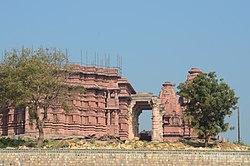This list shows the largest Jain bands in India.
- Shree adijin band ( Goregaon , Mumbai )
This list shows the largest Jain bands in India.
| Rank | Name of the temple | Photo | Area (m2) | Place | Country | Notes |
|---|---|---|---|---|---|---|
| 1 | Shree Pavapuri Tirth Dham |  | 650,000 | Rajasthan | Shree Pavapuri Tirth Dham was built by K. P. Sanghvi Group in 2001. The temple premises comprises a Jain temple complex and Animal Welfare center. [1] | |
| 2 | Manilakshmi Jain Tirth |  | 178,062 | Gujarat | ||
| 3 | Digamber Jain Bada Mandir |  | 161,874 | Uttar Pradesh |
Contents | |
| 4 | Jambudweep |  | 121,406 | Uttar Pradesh | Jambudweep built under the blessings of Gyanmati Mataji in 1972. [2] Jambudweep in Hastinapur is a depiction of Jambudvipa. [3] | |
| 5 | Nemawar Jain temple |  | 84,984 | Madhya Pradesh | Nemawar Jain temple has 26 shrines. One temple is 151 feet (46 m) high housing idols of Panchbalayati. Sahasrakoot Jinalaya, 2nd temple, made of yellow stone enshrines 1008 idols. 12 temples in two lines surrounding first and second temple, each housing 3 idols. [4] | |
| 6 | Ahichchhatra Chaubisi temple |  | 17,500 | Uttar Pradesh | Ahichchhatra is believed to be the place where Parshvanatha, the 23rd Tirthankar of Jainism, attained Kevala Jnana (omniscience). The Chaubisi temple is located near the old Digambara Jain temple. [5] | |
| 7 | Sarvodaya Jain temple |  | 16,000 | Madhya Pradesh | Sarvodaya Jain temple construction started under the guidance of Acharya Vidyasagar in 2006. [6] The temple, is being constructed using lime and preserved stones. The temple complex constructed without cement and iron. The mulnayak of the temple is a 24 feet (7.3 m) tall Ashtadhatu idol of Rishabhanatha in Padmasan posture. [7] | |
| 8 | Padampura |  | 4,600 | Rajasthan | Padampura Jain temple was built in 1944 CE upon discovered of a red stone idol of Padmaprabha. Padampura temple is a famous Jain pilgrimage and famous for miracles. The main attraction of the temple is a 27 feet (8.2 m) colossus of Padamprabha in kayotsarga posture. [8] | |
| 9 | Ranakpur Jain temple |  | 4,500 | Rajasthan | Ranakpur Jain temple was built Dharna Shah, a Porwal from Ghanerao under the patronage of Rana Kumbha, in 1435 CE. [9] } This temple is famous for its intricate carvings and unique architecture. [10] [11] The 15th-century temple dedicated to Adinatha [12] built using white marble in the midst of a forest. The temple name is credited to its design of chaumukha— with four faces, built in the form of Nalini-Gulma Vimana(a heavenly vehicle). [13] [9] | |
| 10 | Kulpakji |  | 4,050 | Telangana | Kulpakji also Kolanupaka Temple is a 2,000 year-old temple. [14] [15] The interior of the temple is made by red sandstone and white marble. Lord Rishabha, popularly called Adinath Bhagvan, was the first Tirthankar in Jainism. The statue of Lord Mahaveer is 130 centimetres (51 in) tall and is said to be made of a single piece of jade. Idols of Lord Simandar Swami and Mata Padmavati are installed on either side of the main temple. [16] [17] |